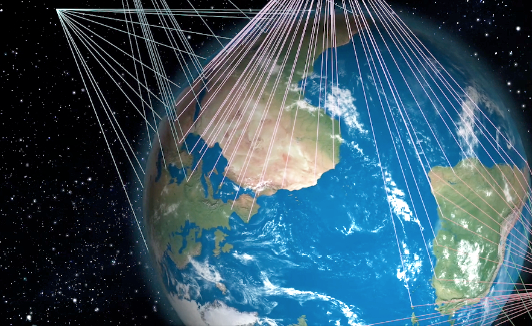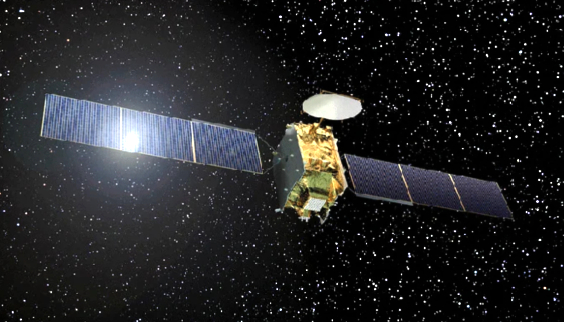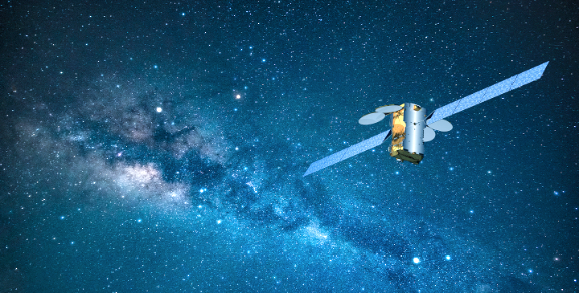This year’s prospects remain rather grim...This year’s prospects remain rather grim...

Telesat delivered their quarterly results on May 14, wrapping up the last of the ‘big four’ satellite operators’ financial reports. The firm’s financials were typical of the sector in general, although Telesat managed to deliver a profit despite a 9 percent fall in revenues (y-o-y) as its cruise and airline clients themselves suffered losses brought upon by the global pandemic.
Telesat reported revenues of $190 million for the threemonth period ending March 31, down from $208.7 million a year earlier, with the end result being a net profit of $42 million.
However, much of the post-results analyst call focused on progress being made with Telesat’s Lightspeed LEO project, and a strong statement as to the much planned IPO and how cash will be raised to fund the project. Telesat will receive $344 million from ‘south of the border’ and the FCC incentive payments for the company’s C-band auction last year. However, President/CEO Dan Goldberg told analysts that he was hoping Telesat could auction off their Canadian C-band frequencies themselves, instead of Industry Canada.
Telesat’s fall in revenues were replicated across some of its three rivals: Intelsat, SES and Eutelsat. All suffered reductions — sometimes severe — in their key verticals.
Interestingly, Intelsat’s overall revenue numbers were up, with the company stating their total revenues for the quarter were $502.7 million ($458.8 million in 2020), up by 9.6 percent y-o-y. While the company is still working their way through Chapter 11 bankruptcy reconstruction, Intelsat’s net loss position also improved to $174.9 million (from $218.7 million in 2020).
Intelsat’s Network services division (and 43 percent of total revenues) was $214 million ($149.4 million in 2020) and that number was helped by the inclusion of their now- integrated Gogo Commercial Aviation subsidiary. Overall, this was an improvement of 43 percent y-o-y. Gogo CA was worth $56.2 million, even during this miserable operating period.
 Intelsat’s Media segment (and 37 percent of overall revenues) fell back 10 percent, or $20.8 million to $184.9 million, down from $205.8 million. The company reported,“The decline in media was primarily driven by a planned service migration by a specific customer from Intelsat’s network to the customer’s own network assets.” Worth noting is that a year ago (Q1/2020) Intelsat’s Media business represented 45 percent of the company’s revenues and had fallen during the year by 9 percent — Intelsat’s Media-related revenues continue to be under pressure.
Intelsat’s Media segment (and 37 percent of overall revenues) fell back 10 percent, or $20.8 million to $184.9 million, down from $205.8 million. The company reported,“The decline in media was primarily driven by a planned service migration by a specific customer from Intelsat’s network to the customer’s own network assets.” Worth noting is that a year ago (Q1/2020) Intelsat’s Media business represented 45 percent of the company’s revenues and had fallen during the year by 9 percent — Intelsat’s Media-related revenues continue to be under pressure.
Intelsat’s Government business (19 percent of revenues) grew by 2 percent to $97.9 million (up from $95.7 million). Intelsat’s contracted backlog stood at $5.9 billion as of March 31 ($6.1 billion at December 31, 2020). But a year ago (Q1/2020), the backlog stood at $6.6 billion. The March 31 ‘fill rate’ was 73 percent “similar to our average fill rate at Dec 31st.” However, a year ago, the fill rate was a far more impressive 78.5 percent.
Intelsat said that their legal dispute with SES, where SES is claiming an overall $1.8 billion in monetary and punitive damages, will come to a head starting on June 28 at bankruptcy court.
SES used its Q3 results to announce a 100 million euros share buy back for cancellation, but also stressed to analysts that the company had made a strong start to their 2021 financial year. The firm’s currently, all-important Video division is moving steadily forward, albeit from terrible losses to not-quite-so-bad losses. SES has seen their Video revenues improve from a -8 percent overall y-o-y fall to a -4.6 percent y-o-y for Q1. Overall, Q1 revenues declined by 2.8 percent y-o-y.
The company’s increasingly important Networks division’s underlying revenue of 173 million was flat when compared with Q1 2020 (+0.1 percent at constant FX), with strong ongoing growth in Government (+8.5 percent) offsetting COVID-related impacts on Mobility (-9.1 percent), while Fixed Data (-1.0 percent) was in line with the prior period.

Artistic rendition of Intelsat’s satellite fleet.
“In summary, our start to the year puts us firmly on track to deliver on our 2021 financial outlook which remains unchanged,” said CEO Steve Collar. “I am excited by the progress that we are making in securing customer commitments for SES-17 and O3b mPOWER ahead of launch in the second half of 2021, and the level of market interest that we are seeing across all Networks verticals. These important growth investments allow us to offer a significantly expanded set of low latency products and solutions to the market as the world emerges from the COVID environment and demand for connectivity increases exponentially. We are also on course with the clearing of C-band in the US and are continuing to pursue opportunities to create additional shareholder value from further monetization initiatives.”
Highlights of the Q1 results statement include:
• More than 85 percent of 2021 revenue outlook (1,760 to 1,820 million euros) already under contract
• $180 million of backlog signed in 2021 for SES-17 and O3b mPOWER, with gross backlog at $740 million; timed to come to market as the world emerges from the COVID invasion with highly differentiated products and solutions to capture substantial, connectivity growth opportunities
• US C-band clearing on track to meet end-2021 milestone (triggering a $1 billion FCC payment) and end-2023 milestone (triggering a further $3 billion payment).

Artistic rendition of the SES O3b mPOWER constellation.
Importantly, Collar’s presentation delivered some strong hints as to how the $3 billion in FCC incentive payment might be spent by the firm. The quarter’s results, and an apparent commitment that SES would use part of their $3 billion, second-tranche payment from the FCC’s incentive C-band compensation for “shareholder benefits,” also helped bring confidence into an overview.
Collar also spoke about future C-band compensations from Canada (“in the shorter term”) and Brazil (“not a huge monetization value”), as well as further opportunities for cash to flow from the US over C-band frequencies. He stressed that the company’s own work in clearing spectrum and fitting filters for its US clients as part of the C-band process was ahead of schedule.
He told analysts this year would see Video revenues stabilizing (“the [downward] curve is flattening” he said, and that this year’s overall -6 percent fall would be comfortably within guidance and intimated that figure would be beaten. He said the rate of Video contracted renewals was good, with 90 percent now contracted. Sky had now renewed to 2027 and there was “excellent momentum. Recovery will not be miraculous this year, but will return in 2022.” Acceleration would occur in 2022, helped by revenues from SES-17’s launch and the introduction to the SES fleet of the first O3b mPower satellites. Thereafter, he said, 2023 would experience growth.
Eutelsat’s Q3 results showed negative growth in almost all of the company’s key divisions; however, the company told analysts that prospects were looking up and, that by year-end (June 30), revenue numbers will have improved. As Eutelsat’s next financial year starts (July 1) and their $550 million stake in OneWeb wraps, then “compelling” benefits will accrue for 2022 and into the future.
However, even the OneWeb investment created comment, with Sami Kassab (satellite analyst at Exane/BNPP) saying the results were a “mixed bag”, adding,“The acquisition of a c24 percent stake in OneWeb is a positive development but lack of full control and perceived technological weakness of this new entrant has us remain on the cautious side.”
Eutelsat’s losses, in hard cash, were miserable. For example, the company’s worsening Broadcast/Video segment (62 percent of revenues) fell by 8.5 percent, while Data & Professional Video (13 percent of revenues) fell 11.8 percent. Government services (13 percent of revenues) were down 8.2 percent and Mobile Connectivity crashed 24.5 percent. The only bright spot for the company was Fixed Broadband (7 percent of revenues), which grew 9 percent. Add this up and the translation into revenues is 301.3 million euros (322 million euros, same period last year) and a fall of 6.4 percent, overall.
Not helping matters is further slippage in Eutelsat’s launch of their Quantum super-satellite which, for the second time, has had the launch date delayed, now alleged to be happening this autumn.

Artistic rendition of the Eutelsat Quantum “super-satellite.”
However, Eutelsat did redeem itself by telling analysts that the firm was upping their guidance for this full trading year to revenues of 1.2 to 1.22 billion euros (up 10 million euros from the lower end of its guidance).
“Management are clear, however, that absolute revenue in 4Q21 should be similar to Q3, which would put the Full Year revenue on c.€750m, and about 1 percent ahead of consensus,” said Giles Thorne, equity analyst at investment bank Jefferies.
Analyst Kassab added that the decline in core Broadcast/ Video revenues was a worry and stands in contrast with those of SES, where Video trends have improved. Kassab points out that revenue declines (“price concessions”) in Greece and lower capacity demand were the main drivers of the revenue falls.
Giles Thorne said there was little else of note to emerge from Eutelsat. “There was nothing to advance the debate on the Nilesat [Egyptian contract] renewal; Eutelsat continues to work optimistically on further wholesale capacity agreements with European telcos for Konnect and Konnect VHTS; despite the promising contract win with Global Eagle Entertainment, the near-term outlook on Mobility is still uncertain; while the closure of Orby TV in the US will have a negligible effect on revenue.”
There were other Eutelsat operational and financial highlights. For example, the company’s contracted backlog was up 6 percent to 4.5 billion euros from 4.2 billion a
year ago (and helped significantly by the renewal of Sky Italia’s pay-TV contracts). The number of operational transponders as of March 31, 2021, stood at 1,366, down by 11 units y-o-y and 14 q-o-q, reflecting principally the end of life in stable orbit of the Eutelsat 48D satellite.
At March 31, 2021, the total number of channels broadcast by Eutelsat satellites stood at 6,864 stable y-o-y and up 4 percent q-o-q. The number of HD channels stood at 1,853 versus 1,667 a year earlier, up by 11 percent and represented 27.0 percent of channels when compared with 24.3 percent a year earlier.
Thorne, (in his “The Empire Buys Back” report), said the SES Q1 numbers were “collectively constituting a clarion call from this old-guard satellite incumbent to value investors that the market has got it wrong.” He added, “Inevitably, the Eutelsat $550 million investment in OneWeb was a backdrop for new lines of inquiry into industry consolidation (response: the sector still needs consolidation, being in different orbits doesn’t preclude consolidation, some consolidation synergies can perhaps be achieved via technology, SES will be watchful and opportunistic) and competition (response: LEO is still hard to commercialize, MEO sweet-spot of service and bandwidth economics, the service-wrapper allows for value-based pricing, SES’s first-mover status in Cloud looks well protected).”

Artistic rendition of Viasat’s KA-SAT satellite.
Meanwhile, there was plenty of other news for the market to digest. For example, Viasat has closed their purchase of Eutelsat’s 51 percent share of theirs Euro Broadband Infrastructure (EBI) business which includes Eutelsat’s KA- Sat ‘broadband’ satellite.
A wholesale broadband services business, EBI was created as part of Viasat’s previous partnership arrangement with Eutelsat. Providing fixed and mobile broadband services on a wholesale basis in the European and Mediterranean markets, EBI was 51 percent owned by Eutelsat, with Viasat holding 49 percent. The 51 percent controlling interest in EBI has now been acquired for 140 million, subject to customary net working capital and net debt adjustments. The purchase price will be funded with available cash, resulting in a cash outlay of 50 million euros, net of approximately 90 million of EBI’s cash on hand.
“[The] transaction accelerates Viasat’s European broadband objectives by strengthening our services footprint and facilitating further market penetration,” said Keven Lippert, CCO/Viasat. “By gaining full control of KA-SAT, Viasat can further expand its growing mobility business as well as establish operations and market presence ahead of our ViaSat-3 service launch, including the introduction of new capabilities enabling high-speed, high-bandwidth ‘ViaSat-3-like’ home internet service plans in select European markets.”
Another major move is Eutelsat’s lease of their 7A/139WA craft to Global Eagle Entertainment. The satellite is stationary and offers Ku-band capacity (although nobody is saying exactly how much, or the value of the contract) and the craft is in inclined orbit. Global Eagle (GEE) want the capacity to serve their airline customers and the deal covers “multi-year, multi-transponder” usage. The satellite has been moved to its new location and has been renamed Eutelsat 139WA. The 139 degrees longitude places the satellite above the eastern-Pacific, although it is well placed to serve Alaska and North (and South) America, depending on the craft’s working footprints.
Eutelsat has also added extra muscle to their agreement with Facebook for capacity to sub-Saharan Africa. Facebook will use Eutelsat’s Konnect satellite and service to expand satellite broadband in rural and underserved communities. With Express Wi-Fi, Eutelsat aims to connect thousands of people in the rural and underserved communities that span the Democratic Republic of Congo (DRC), Nigeria, Côte d’Ivoire, Tanzania, Uganda, Zambia, Kenya, Madagascar, South Africa, Cameroon, Ghana and Zimbabwe, stated Eutelsat.
The Facebook news, said Kassab, adds another distribution channel for Eutelsat Konnect with a well-recognized partner (Facebook). “Over the last three years, Echostar has developed over 5,000 Express Wi-Fi hotspots in Latin America. We believe these hotspots generate attractive ARPUs for satellite operators,” he said.
In summary, 2020 was a not so great year for satellite operators. Any progress made this year in any of the operator’s key verticals is praiseworthy.
For the industry in general 2021 — at best — remains flat, although a recovery in cruise and airline traffic as well as increased connectivity demands, will help confidence to return to the industry — 2022 should definitely be better. Network activity should return, Intelsat will be out of bankruptcy (hopefully) and all will know the result of the SES litigation. SES’s mPower will be in business, and Eutelsat might be looking at the start of commercial activity via their OneWeb investment.
In other words, roll on 2022!
Opening image is courtesy of Daniel Svoboda from Unsplash.
 Author Chris Forrester is a well-known broadcasting journalist, industry consultant and Senior Columnist for SatNews Publishers. He reports on all aspects of broadcasting with special emphasis on content, the business of television and emerging applications. He founded Rapid TV News and has edited Interspace and its successor Inside Satellite TV since 1996. He also files for Advanced-Television.com. In November of 1998, Chris was appointed an Associate (professor) of the prestigious Adham Center for Television Journalism, part of the American University in Cairo (AUC), in recognition of his extensive coverage of the Arab media market.
Author Chris Forrester is a well-known broadcasting journalist, industry consultant and Senior Columnist for SatNews Publishers. He reports on all aspects of broadcasting with special emphasis on content, the business of television and emerging applications. He founded Rapid TV News and has edited Interspace and its successor Inside Satellite TV since 1996. He also files for Advanced-Television.com. In November of 1998, Chris was appointed an Associate (professor) of the prestigious Adham Center for Television Journalism, part of the American University in Cairo (AUC), in recognition of his extensive coverage of the Arab media market.

